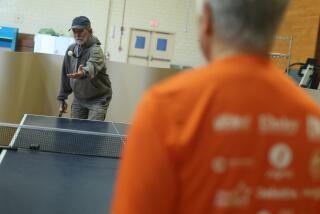VA may be saving veterans from suicide
- Share via
Military veterans who receive healthcare through the U.S. Department of Veterans Affairs commit suicide at lower rates than those outside the system, according to government data.
VA researchers said the data suggest that the agency’s suicide prevention programs are working for veterans who use them -- though they also acknowledged that the lower rates may also reflect an underlying willingness to seek help.
The differences were especially stark among women, whose overall suicide rates are only now becoming clear.
The Times reported this week that female veterans commit suicide at nearly six times the rate of other women, based on a government analysis of all 173,969 adult suicides -- men and women, veterans and nonveterans -- in 23 states between 2000 and 2010.
Age-group breakdowns provided to The Times showed that the rates remained elevated across all generations of women who served. In contrast, the rates for men were elevated only for those under 50.
To counter criticism that it is not doing enough to stop suicide, the VA is trying to draw attention to one bright spot in the data: lower suicide rates for veterans enrolled in healthcare there.
“I think it’s important to understand that the enhanced care that we provide at VA is making a difference,” Dr. Caitlin Thompson, deputy director for suicide prevention, said in an article posted Tuesday evening on the VA blog.
Suicide rates are typically expressed in the number of deaths per 100,000 people each year.
For female veterans using the VA, that number held relatively steady over the 11 years included in the data, averaging 10.3.
The figure for women who didn’t seek VA help started out at 29.9 in 2000 and climbed steadily, reaching 43.6 in 2010.
For male VA users, it fell from 37.3 to 29.1.
In contrast, it rose from 27.5 to 38.3 for male nonusers.
Robert Bossarte, a VA epidemiologist who was part of the research, said that given the rising rates among non-VA users -- as well as a slight uptick in suicides in the general population -- flat rates for VA users suggest that mental health treatment is working.
Still, he and other researchers said that without more research, the causes of the differences cannot be known for certain.
The VA saw a large influx of new patients over the course of the study, and it is unclear how that might have changed underlying risk patterns.
In addition, researchers are unable demonstrate that VA efforts to ramp up suicide-prevention programs beginning in 2007 had a clear effect. Most of the improvement in suicide rates among male VA users occurred before then.
In any case, officials said that more needs to be done to draw more at-risk veterans into treatment.
In 2010, 28% of the 892,373 female veterans in the data and 25% of the 10.4 million men were enrolled in the VA.
The veterans most likely to use the VA were men 60 and older and women between 50 and 69, according to the data.
But the suicide risk relative to nonveterans was highest in veterans 18 to 29. In that age group, female veterans were nearly 12 more likely than other women to take their lives. Suicide rates for male veterans were almost five time higher than those of other men.
In an interview, Thompson pointed to several anti-suicide measures the VA had begun over the last eight years, including flagging medical records of those deemed at risk, special training for staff members, creation of a veterans’ crisis line, placing a suicide-prevention coordinator at each medical center and community outreach efforts to identify veterans in trouble.
“The new data on women veterans is going to focus our attention,” she said. “We still have so much work to do.”
Twitter: @alanzarembo
More to Read
Sign up for Essential California
The most important California stories and recommendations in your inbox every morning.
You may occasionally receive promotional content from the Los Angeles Times.














